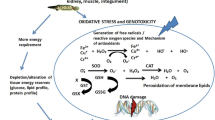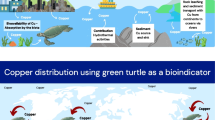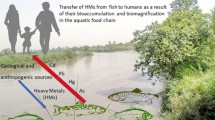Abstract
The Anzali Wetland is one of the most important ecosystems in the north of Iran, and parts of it were registered as a Ramsar site in 1975. However, even though, due to many problems, including eutrophication produced by inflow of excess nutrients and organic materials, the wetland was also listed on the Montreux Record indicating the need to take urgent remedial action. This study was conducted to study the levels of polychlorinated biphenyls (PCBs) and total mercury (THg) in two fish species (Esox lucius and Carassius auratus) as bio-indicators of the ecosystem condition in eastern part of Anzali Wetland. The sampling was carried out in six different periods between years 2009 and 2010. The results showed that the amounts of PCBs in the muscle of northern pike were below the detection limit of gas chromatography, whereas the average concentration in goldfish was 0.449 mg/kg wet weight. Some possible reasons for the higher levels of PCBs in goldfish in comparison with pike have been discussed. No significant (p < 0.05) correlation was observed between PCBs and biological factors (weight, length, lipid content) for both species. On the other hand, the mean concentration of THg in the muscle of pike and goldfish were 182.22 and 75.27 ng/g dry weight, respectively. Although these concentrations were below US-EPA criterion for human consumption (0.3 mg/kg), it pointed up a significant deterioration of the ecosystem condition during the past years. Finally, statistical analysis revealed a significant correlation between THg with weight and an insignificant correlation with length for pike specimens.




Similar content being viewed by others
References
Akbarzadeh, A., Laghaib, H. A., Monavari, M., Nezamid, S. A., Shokrzadeh, M., & Saravi, S. S. S. (2008). Survey and determination of Anzali Wetland trophic state through geographic information systems (GIS). Toxicological and Environmental Chemistry, 6, 1055–1062. doi:10.1080/02772240701850681.
Al-Majid, N. B., & Preston, M. R. (2000). Factors influencing the total mercury and methyl mercury in the hair of the fishermen of Kuwait. Environmental Pollution, 109, 239–250. doi:10.1016/S0269-7491(99)00261-4.
Ashja Ardalan, A., Khoshkhoo, Z. H., Rabbani, M., & Moini, S. (2006). Comparative study for heavy metal concentration(Zn, Cu, Pb, Cd and Hg) in water, sediments and soft tissue of Anzali wetland anodont (Anodonta cygnea) sampled in two seasons, autumn and spring. Pajouhesh & Sazandegi, 73, 103–113. doi:10.1016/S0043-1354(96)00323-5.
Barron, M. G. (1990). Bioconcentration. Environmental Science and Technology., 24, 1612–1618. doi:10.1021/es00081a001.
Berglund, O., Larsson, P., Ewald, G., & Okla, L. (2001). Influence of trophic status on PCB distribution in lake sediments and biota. Environmental Pollution, 113, 199–210. doi:10.1016/S0269-7491(00)00166-4.
Blanchard, M., Teil, M. J., Carru, A. M., Chesterikoff, A., & Chevreuil, M. (1997). Organochlorine distribution and mono-orthosubstituted PCB pattern in the roach (Rutilus rutilus) from the River Seine. Water Resources, 31, 1455–1461. doi:10.1016/S0043-1354(96)00383-1.
Borgman, U. (1985). Predicting the effect of toxic substances on pelagic ecosystems. Science of the Total Environment, 44, 111–121. doi:10.1016/0048-9697(85)90115-9.
Carlberg, G. E., Martinsen, K., Kringstad, A., Gjessing, E., Grande, M., Kallqvist, T., et al. (1986). Influence of aquatic humus on the bioavailability of chlorinated micropollutants in Atlantic salmon. Archives of Environmental Contamination and Toxicology, 15, 543–548. doi:10.1007/BF01056568.
Castilhos, Z. C., & Bidone, E. D. (2000). Hg biomagnification in the lchthyofauna of the Tapajós River Region, Amazonia, Brazil. Bulletin of Environmental Contamination and Toxicology, 64, 693–700. doi:10.1007/s001280000059.
Danielsson, S. (2007). Impact of biological factors in monitoring of contaminants in Perch (Perca fluviatilis), B.S. Project, Stockholm University.
Gudkov, P. K. (1985). Biology of goldfish, Carassius auratus gibelio, from the Volga Delta. Journal of Ichthyology, 25, 157–160.
Hecky, R., Ramsey, D. J., Bodaly, R. A., & Strange, N. E. (1991). Increased methylmercury contamination in fish in newly formed freshwater reservoirs. In T. Suzuki, N. Imura, & T. W. Clarkson (Eds.), Advances in mercury toxicology (pp. 33–52). New York: Plenum Press.
Jackson, L. J., Carpenter, S. R., Manchester-Neesvie, J., & Stow, C. A. (2001). PCB congeners in Lake Michigan Coho (Oncorhynchus kisutch) and Chinook (Oncorhynchus tshawytscha) salmon. Environmental Science and Technology, 35, 856–862. doi:10.1021/es001558.
Larsson, P., Collvin, L., Okla, L., & Meyers, G. (1992). Lake productivity and water chemistry as governors of the uptake of persistent pollutants in fish. Environmental Science and Technology, 26, 346–352. doi:10.1021/es00026a016.
Larsson, P., Okla, L., & Collvin, L. (1993). Reproductive status and lipid contents as factors in PCB, DDT and HCH contamination of a population of pike (Esox lucius L.). Environmental Toxicology and Chemislry, 12, 855–861. doi:10.1002/etc.5620120509.
McCarthy, J. E. (1983). Role of particulate organic matter in decreasing accumulation of polynuclear aromatic hydrocarbons by Daphnia magna. Archives of Environmental Contamination and Toxicology, 12, 559–568. doi:10.1007/BF01056552.
Morel, F. M., Kraepiel, M., & Amyot, M. (1998). The chemical cycle and bioaccumulation of mercury. Annual Reviews of Ecology and Systematics, 29, 543–566.
Mueller, K.A., Snyder-Conn, E., and Scannell, P.O. (1995). Metal and metalloid contaminants in water, sediments, and fish of Kanuti National Wildlife Refuge, Alaska, 1985–1990. Ecological Services, Fairbanks,Alaska, U.S. Fish and Wildlife Service. Technical report NAES-TR-95-02; 125.
Otchere, F. A. (2005). Organochlorines (PCBs and pesticides) in the bivalves Anadara (Senilis) senilis, Crassostrea tulipa and Perna perna from the wetlands of Ghana. Science of the Total Environment, 348, 102–114. doi:10.1016/j.scitotenv.2004.12.069.
Pourang, N. (1994). Heavy metal bioaccumulation in different tissues of two fish species with regards to their feeding habits and trophic levels. Environmental Monitoring and Assessment, 35, 207–219. doi:10.1007/BF00547632.
Pourang, N. (1996). Heavy metal concentrations in surficial sediments and benthic macroinvertebrates from Anzali Wetland, Iran. Hydrobiologia, 331, 53–61. doi:10.1007/BF00025407.
Pourang, N., Richardson, C. A., & Mortazavi, M. S. (2010). Heavy metal concentrations in the soft tissues of swan mussel (Anodonta cygnea) and surficial sediments from Anzali Wetland, Iran. Environmental Monitoring and Assessment, 163, 195–213. doi:10.1007/s10661-009-0827-7.
Sorensen, E. M. B. (1991). Metal poisoning in fish. Boca Raton: CRC Press.
ST Louis, V., Rudd, J., Kelly, C. A., Beaty, K. G., Bloom, N. S., & Flett, R. J. (1994). Importance of wetlands as sources of methyl mercury to boreal forest ecoystems. Canadian Journal of Fisheries and Aquatic Sciences, 51, 1065–1076.
Tahershamsi, A., Bakhtiary, A., & Mousavi, A. (2009). Effects of seasonal climate change on chemical oxygen demand (COD) concentration in the Anzali Wetland (Iran). Cairns, Australia: 18th World IMACS/MODSIM Congress.
Talebi, K. (1998). Diazinon residues in the basins of Anzali Wetland, Iran. Bulletin of Environmental Contamination and Toxicology, 61, 477–483. doi:10.1007/s001289900787.
Wallen, I. E. (1951). The direct effect of turbidity on fishes. Bulletin of the Oklahoma Agricultural Experiment Station, 48, 1–27.
WHO. (1989). Environmental health criteria 101: methylmercury. Geneva: World Health Organization.
Yamaguchi, N., Gazzard, D., Scholey, G., & Macdonald, D. W. (2003). Concentrations and hazard assessment of PCBs, organochlorine pesticides and mercury in fish species from the upper Thames: river pollution and its potential effects on top predators. Chemosphere, 50, 265–273. doi:10.1016/S0045-6535(02)00482-4.
Yazdanparast, F., Nouri, A., & Rabbani, M. (2004). Identification and determination of PAHs compounds in Anzali International Wetland. International journal of Environmental Science and Technology, 3, 215–219.
YEKOM. (1990). First-phase of comprehensive studies for Taleb-e-Anzali Rehabilitation Project. Annex II. Summary Report in English (Vol. XIII). Tehran: YEKOM Consulting Engineers.
Zhang, Z. L., Hong, H. S., Zhou, J. L., Huang, J., & Yu, G. (2003). Fate and assessment of persistent organic pollutants in water and sediment from Minjiang River Estuary, Southeast China. Chemosphere, 52, 1423–1430. doi:10.1016/S0045-6535(03)00478-8.
Zhou, J. L., & Rowland, S. L. (1997). Evaluation of the interactions between hydrophobic organic pollutants and suspended particles in estuarine waters. Water Research, 31, 1708–1718. doi:10.1016/S0043-1354(96)00323-5.
Zolfaghari, G., Esmaeili Sari, A., Ghasempouri, S. M., Ghorbani, F., Ahmadifard, N. A., & Shokri, Z. (2007). The comparison of relation between age, sex and weight with mercury concentration in different tissues of Chalcalburnus chalcoides from Anzali Wetland, Iran. Journal of Marine Sciences and Technology, 5, 23–31.
Acknowledgments
The authors are grateful to Inland Waters Aquaculture Research Centre of Anzali for their aid in sampling and field activities. The help of Mr. H. Yousefzadeh with statistical analysis is greatly appreciated. This project was funded by Tarbiat Modares University.
Author information
Authors and Affiliations
Corresponding authors
Rights and permissions
About this article
Cite this article
Sakizadeh, M., Esmaeili Sari, A., Abdoli, A. et al. Determination of polychlorinated biphenyls and total mercury in two fish species (Esox lucius and Carassius auratus) in Anzali Wetland, Iran. Environ Monit Assess 184, 3231–3237 (2012). https://doi.org/10.1007/s10661-011-2184-6
Received:
Accepted:
Published:
Issue Date:
DOI: https://doi.org/10.1007/s10661-011-2184-6




